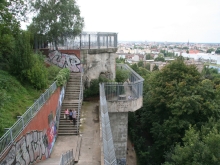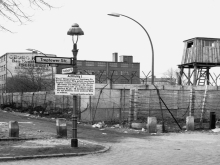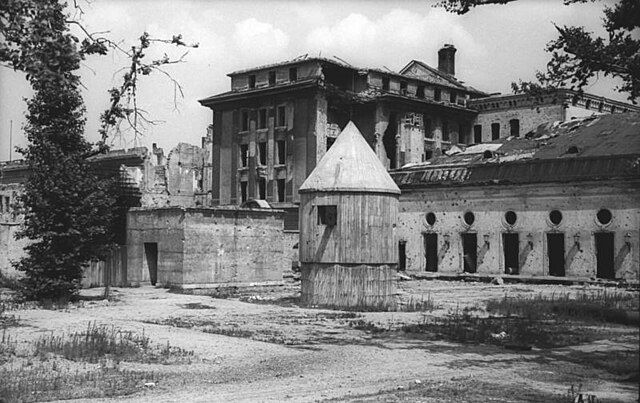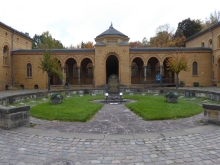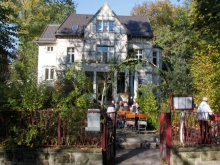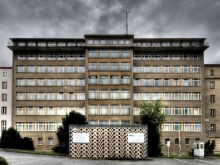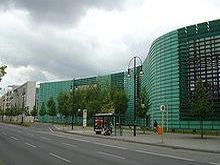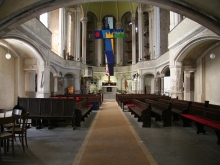Other places of interest and excursion destinations in other countries:
 |
 |
 |
 |
 |
 |
 |
 |
FR |
IT |
MT |
NL |
PL |
PT |
ES |
DE |
Link: Worth visiting in Berlin
Berlin - Teufelsberg

Teufelsberg in Grunewald
The views over Grunewald and to Havel are uniquely beautiful. The TV tower and the Berliner Dom can be seen to the east in good weather. To the west you can see sailboats on the water. Teufelsberg is built on a mountain of rubble from the time of the war. During the Nazi era, there was a military faculty on the site and after the war 25 million cubic meters of rubble from Berlin were poured on top. Teufelsberg, is named after the nearby "Devil's Lake" and became the highest point in Berlin at 114.7 meters after the Müggelberge. The Americans started using the "mountain" as a listening post in the 50's. One can still see the remains of the installation with the five large radar domes today.

Teufelsberg in Grunewald - Homemade postcard
The story:Teufelsberg ("Devil's Mountain"), is an artificial hill in Grunewald on the outskirts of the former West Berlin. The hill is located approx. 120 meters above sea level and it was created from rubble and waste from the clean-up of the city after the war. Under the debris is an unfinished Nazi building - the Military Technical College (Wehrtechnische Fakultät), which was designed by Albert Speer.
Albert Speer began the construction of the Wehrtechnische Fakultät on November 28, 1937, after Hitler had laid the foundation stone. The project was intended as part of the East-West axis and the school was supposed to teach the new military elite. However, construction was put on hold when the head of construction development, Karl Becker, committed suicide in April 1940, presumably due to harsh criticism from Hitler and other top Nazis for the inability to maintain a strong military production.
Later, Reichsmarschall Hermann Göring ordered that all "militarily insignificant" construction projects to be stopped, including work on the Wehrtechnische Fakultät. The buildings were not expected to be completed until after the "final victory", which never came.
Albert Speer designed the Wehrtechnische Fakultät as a castle, both to
capture the grandeur and power of the Nazi army, but also to act as a
defensive measure if necessary. The school was also part of a larger project
for the development of the East-West axis, a planned axis from the city
center in the east - Alexanderplatz - past the Siegessäule - and to the
Olympic Stadium.
In addition, the Wehrtechnische Fakultät was intended as the first part of a
'Hochschulstadt', a large university center where not only Berlin&'s
universities, but also the affiliated clinics (Charité hospital and the Zoological
and Botanical Gardens) were to be rebuilt according to the plans of the
General Building Inspector and later Reich Minister of Armaments and War
Production, Albert Speer.

Wehrtechnische Fakultät
After the war, it was decided that it was
easier to cover the school with rubble than to try to blow up the sturdy
structure. Thus the Wehrtechnische Fakultät was buried under what is now the
Teufelsberg.
In addition to being an unfinished military-technical college and later a
listening post during the Cold War, the Wehrtechnische Fakultät was also
used as a weather station during the war.

Wehrtechnische Fakultät
After the construction of the Berlin Wall
in 1961, an agreement was reached between the British and the Americans for
joint use of the area and in 1961 the US Special Operations Unit (SOU)
installed mobile facilities on Teufelsberg, while the British monitored
Warsaw Pact air traffic.
"Field Station Berlin" on Teufelsberg was continuously expanded and became
one of the most important listening posts during the Cold War, where it was
primarily run by the National Security Agency (NSA) and functioned as part
of the global espionage network Echelon. The station's location on the
Teufelsberg, the highest point in West Berlin, allowed it to receive signals
from all directions and on all frequency bands that would otherwise be
difficult to pick up over long distances.
The NSA left Teufelsberg after the end of the Cold War. After, the complex was used for air traffic control until 1999, when it was sold. Today, the area is known for its historical significance and is a popular excursion destination.

Teufelsberg 2013
Address:
Teufelsseechaussee 10
Gruewald
Distance:
Guided tours:
Guided tours are offered daily every full hour from kl. 12 - 14 and from 16 and if necessary until sunset.
The tours take visitors to the former canteen and observation tower over to
Radom Unit 1463. It is one of the largest graffiti and street art galleries in
Germany. From the platform of this art house there is a unique view of the city.
The acoustic experience in the domes completes the visit.
Price:
7.00 Euro per person. For children under 15 and for people accompanying the severely disabled, it is free.
Link:


From Teufelsberg in Grunewald - 2013
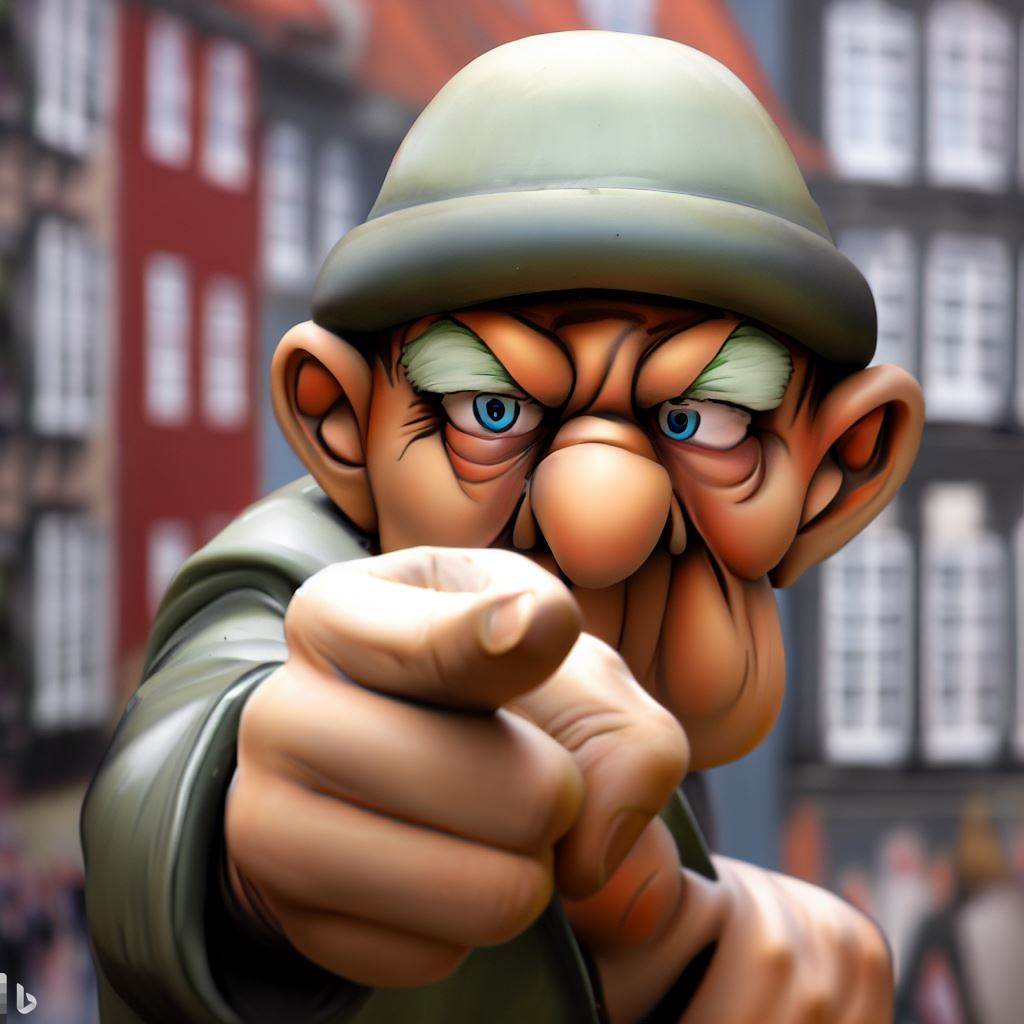
Wanted
Berlin is always worth a visit - summer or winter - but where to go? Here are some slightly unusual and very different suggestions for places I like to go.
D E F
G H I J K
L M N O P Q R S
S T U V X Y Z
Recreational areas:
Food and drinks:
Postcard Berlin, Sebastianstraße, Berliner Mauer Shortcut to postcards of the Berlin Wall
A recommendation
Berlin's landmark is a bear
I have visited Berlin for many years. The first time was in the late 70s with a school
class where the stay made such a big impression on me that I have been coming there
very often ever since.
The first times I visited the city, it was brutally divided into East and West and
separated by the famous and infamous Berlin Wall, which from one day to the next
separated families and friends.
The history of the construction of the Berlin Wall is long and begins in the division of Germany
after World War II, where the four victors and allies - the Soviet Union, the United States, England and France divided the country
between them. The capital, Berlin, from which the Allies were to jointly rule Germany, was also divided into four occupation zones,
which each Allied ruled, however, in accordance with the overall agreements the four Allies had jointly
But the marriage was not a happy one and, in short, the differences between the United States, England and France, on the one hand, and
the Soviet Union, on the other, became so big that cooperation was almost impossible.
The lack of cooperation led the Soviet Union to voluntarily decide to form the state of the GDR
in their part of Germany, where West Berlin were located - now as a desert island in the east.
In the GDR, however, they had the problem that many of its inhabitants would rather live in the somewhat richer "West", where the Americans, unlike the Russians,
provided financial assistance for the reconstruction after the "total war". In the Soviet-occupied German territories, the Russians instead
dismantled most of the production equipment and moved it to the Soviet Union, and to make matters worse, the Germans were also ordered to
pay war damages.
As the flow of refugees from the GDR increased, often by several thousand people a day, the
then government of the GDR felt compelled, with the consent of the Soviet Union, to confine its population, otherwise within a few years there would be so few people
left in the state no longer really would work. The flight to the West among young people, skilled and highly educated was so that the situation was unsustainable
and something had to be done.
The iconic photo of the soldier who escaped from the
GDR to the west
Well arrived in West Berlin, you had to sign up in e.g. the Marienfelde refugee camp to apply for a residence permit.
Here one was interrogated and later typically assigned to a job according to qualifications and an apartment. Many former GDR citizens have passed through
Marienfelde, where there now also is a museum. It is estimated that approx. 1.35 million people passed through the camp in Marienfelde until the fall of
the wall in 1989.
West Berlin was a thorn in the side of the so-called communist regimes, which on several
occasions tried to get the West Allies to leave Berlin and thus let it become part of the GDR, but when that failed, the Berlin Wall or "Antifaschistischer Schutzwall"
as it was officially called in the GDR was built in 1961.
"Notaufnahmelager"
Marienfelde (refugee camp)
The "Schandmauer" - or wall of shame as it was called in most of the western world - came to surround the whole of West Berlin.
The day of shame - 13 August 1961 - was the day when a 41 km long wall was started and further developed the following years right up to the fall of the wall in 1989. Memorial
It is estimated that approx. 14,000 border soldiers guarded the wall
- which by the way consisted of several walls - even though 860,000 mines had been laid, more than 300
watchtowers erected, trenches built and more than 600 well-trained watchdogs exposed.
Throughout the period from 1961 - 1989, it is estimated that there were more than 5,000 escape attempts and that
a little more than 3,000 people were apprehended. Some of these escape attempts took place through the 57 escape
tunnels dug under the Berlin Wall. In all, it is believed that 190 died during escape attempts.
World War II and the Berlin Wall - even after its dismantling - have of course left their mark
on the city of Berlin and there is no doubt that these events have had a colossal historical significance, but one
must not forget that Berlin is also an extremely interesting and modern city, where life is lived and where the
cultural offerings are enormous.
Wanted






The GDR had otherwise promised its population that after some hard years
of toil and toil, the reward would come, but when you could see, not
least via western TV, how the nation actually fell further and further
behind in relation to the west, many began to doubt truth value of the
statement. For the same reason, large parts of the population began to
seep to the west and this could most easily happen via Berlin, where the
borders between the various sectors were still open.
 When a GDR citizen had decided to become a "republican
refugee", he or she typically dressed like people from the West
and then subsequently bought a train ticket to Berlin , if one did not already live there. In Berlin, the trip typically continued by "U-bahn" to West Berlin.
During such an escape, no significant luggage could be included, as one would easily be recognized as what one was - a refugee - and then taken to the police
station for questioning and imprisonment. Although there was free passage to West Berlin, many East German border guards were posted at the border and were
largely solely responsible for keeping an eye on any refugees.
When a GDR citizen had decided to become a "republican
refugee", he or she typically dressed like people from the West
and then subsequently bought a train ticket to Berlin , if one did not already live there. In Berlin, the trip typically continued by "U-bahn" to West Berlin.
During such an escape, no significant luggage could be included, as one would easily be recognized as what one was - a refugee - and then taken to the police
station for questioning and imprisonment. Although there was free passage to West Berlin, many East German border guards were posted at the border and were
largely solely responsible for keeping an eye on any refugees.














